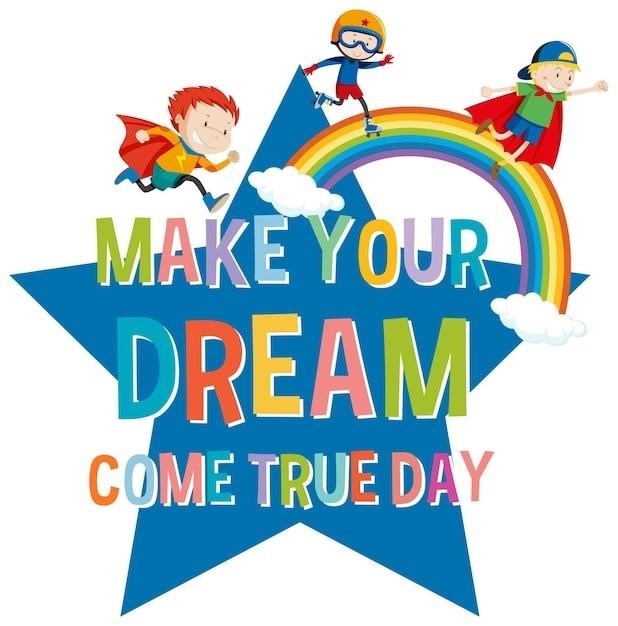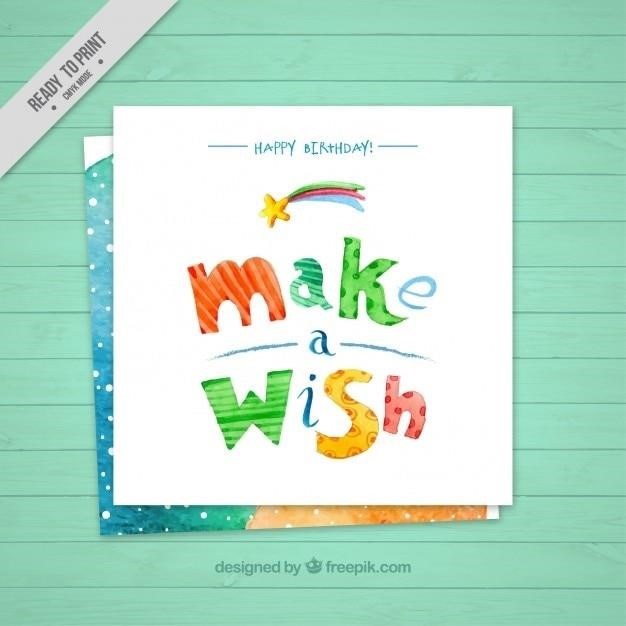
i have a dream book pdf
Dream Books⁚ A Comprehensive Guide
Dream books, also known as dream dictionaries, are guides that offer interpretations of dreams and their potential meanings․ These books typically list common dream symbols and their associated interpretations, often drawing upon folklore, mythology, and cultural traditions․ Dream books can be used for personal reflection, self-discovery, and gaining insights into the subconscious mind․
What is a Dream Book?
A dream book, also known as a dream dictionary, is a guide that provides interpretations of dreams and their potential meanings․ These books typically list common dream symbols and their associated interpretations, drawing upon folklore, mythology, and cultural traditions․ Dream books can be used for personal reflection, self-discovery, and gaining insights into the subconscious mind․
They offer a framework for understanding the symbolism and messages that may be embedded within our dreams․ Dream books can be particularly helpful for individuals who are curious about the meaning of their dreams or who are seeking guidance in navigating their inner world․ By exploring the interpretations provided in a dream book, individuals can gain a deeper understanding of their own thoughts, feelings, and motivations․
The interpretations in dream books are often based on a combination of cultural beliefs, historical practices, and psychological theories․ However, it’s important to note that dream books are not definitive guides and should be used as a starting point for personal exploration․ The meaning of a dream can vary greatly depending on the individual’s personal experiences, beliefs, and emotional state․
Types of Dream Books
Dream books come in various forms, each offering a distinct approach to dream interpretation․ Some common types include⁚
- Traditional Dream Books⁚ These books often draw from ancient folklore, mythology, and cultural beliefs․ They typically provide interpretations based on common dream symbols and their historical associations․ Examples include “The Dream Book” by Zadkiel, which is widely considered a classic in the genre․
- Modern Dream Books⁚ Contemporary dream books often incorporate psychological perspectives and modern interpretations․ They may focus on specific themes, such as relationships, career, or personal growth․ Some modern dream books also utilize scientific research and psychological theories to provide more nuanced interpretations․
- Dream Dictionaries⁚ These books primarily focus on providing definitions of specific dream symbols․ They are often arranged alphabetically, making it easy to look up the meaning of a particular symbol that appeared in a dream․
- Dream Journals⁚ While not strictly a “dream book,” dream journals are valuable tools for recording and analyzing dreams․ They allow individuals to keep track of their dreams, note any recurring themes, and explore potential meanings over time․
The type of dream book that best suits an individual’s needs will depend on their personal preferences, goals, and the level of depth they seek in dream interpretation․
Dream Book Interpretations
Dream book interpretations vary widely, reflecting diverse cultural beliefs, psychological theories, and individual perspectives․ While some interpretations might seem straightforward, others can be complex and require careful consideration․ Here are some common approaches to dream interpretation found in dream books⁚
- Symbolism⁚ Many dream books focus on the symbolic meanings of objects, people, and actions in dreams․ For example, a dream about a snake might symbolize transformation, danger, or hidden desires, depending on the context and the individual’s personal associations․
- Archetypes⁚ Some dream books draw upon Jungian psychology, which emphasizes the role of archetypes in the unconscious mind․ Archetypes are universal patterns of thought and behavior that can appear in dreams, such as the hero, the shadow, or the wise old man․
- Personal Associations⁚ Dream books often encourage individuals to consider their own personal experiences and associations with dream symbols․ What a particular object or event means to one person might be different for another․
- Emotional Significance⁚ Dream interpretations often emphasize the emotional weight of dreams․ The feelings experienced during a dream can offer valuable clues about the underlying message or message․
- Context and Recurring Themes⁚ Dream books may suggest that the context of a dream and any recurring themes are crucial for understanding its meaning․ For example, a dream about being chased might have different interpretations depending on the setting, the chaser, and whether the theme of being chased appears frequently in the dreamer’s dreams․
It’s essential to remember that dream interpretations are subjective, and there is no single “right” interpretation․ The best approach is to use dream books as guides and to consider their interpretations in conjunction with your own personal experiences and intuition․
Using a Dream Book
Using a dream book can be a fascinating and insightful way to explore the world of dreams․ Here are some tips on how to make the most of your dream book⁚
- Keep a Dream Journal⁚ Record your dreams as soon as you wake up, including as many details as possible․ This helps you remember the dream more vividly and can provide context for your interpretations․
- Identify Key Symbols⁚ Look for the most prominent symbols in your dream and search for their interpretations in the dream book․ Consider the emotions you felt in the dream, as they can add further meaning to the symbols․
- Focus on Personal Relevance⁚ While dream books offer general interpretations, it’s important to consider how the symbols relate to your own life and experiences․ What might be a common interpretation for one person could have a different meaning for another․
- Trust Your Intuition⁚ Dream books can be a valuable resource, but ultimately, trust your own instincts and intuition when interpreting your dreams․ If an interpretation feels off or doesn’t resonate with you, don’t force it․
- Use Dream Books as a Starting Point⁚ Dream books can be a helpful starting point for dream exploration, but they shouldn’t be the sole source of interpretation․ Consider seeking guidance from a therapist or dream counselor if you want a deeper understanding of your dreams․
Remember, dreams are a powerful tool for self-discovery․ By using a dream book and paying attention to your own intuition, you can unlock the hidden messages and insights your dreams hold․
The History of Dream Books
The practice of interpreting dreams dates back to ancient times, with dream books evolving as a way to codify and share these interpretations․ Early dream books were often rooted in religious and cultural beliefs, with interpretations tied to omens, prophecies, and divine messages․
One of the earliest known dream books, the “Oneirocritica” by Artemidorus of Daldis, was written in the 2nd century AD․ This comprehensive work categorized dreams by their symbolism and offered detailed interpretations based on the dreamer’s social status, gender, and life circumstances․ Other notable early dream books include the “Book of Dreams” by Ibn Sirin, a 9th-century Arabic scholar, and the “Dream Book” by Gustavus Hindman Miller, published in the late 19th century, which gained immense popularity in the United States․
Throughout history, dream books have served as a tool for understanding the subconscious, exploring the symbolism of dreams, and gaining insight into the dreamer’s personal journey․ They have also been used for entertainment and amusement, offering a glimpse into the cultural beliefs and anxieties of different eras․
Modern Dream Books

Modern dream books continue to reflect the evolving understanding of dreams, incorporating elements of psychology, cultural trends, and personal experiences․ While some adhere to traditional interpretations, others explore new perspectives and acknowledge the subjective nature of dreams․
The accessibility of digital platforms has led to a surge in online dream dictionaries and dream interpretation websites․ These resources offer instant access to a vast database of dream symbols and their potential meanings․ Mobile apps have also emerged, providing interactive dream journals, personalized dream interpretations, and even virtual dream therapists․
Modern dream books also address contemporary anxieties, such as social media, technology, and environmental concerns, reflecting the changing landscape of human experiences and their impact on our dreams․ These books encourage a more nuanced approach to dream interpretation, emphasizing the importance of individual context, personal associations, and the exploration of emotions and subconscious desires․
Creating Your Own Dream Book

For those who seek a more personalized and insightful approach to dream interpretation, creating a personal dream book can be a rewarding endeavor․ This involves keeping a dream journal, meticulously recording dreams and their associated emotions, thoughts, and recurring symbols․ Over time, you can analyze these entries, identifying patterns and potential meanings unique to your own experiences․
A personal dream book can become a valuable tool for self-discovery and understanding․ It allows you to explore your subconscious mind, uncover hidden desires, and gain insights into your waking life․ By tracking your dreams and their interpretations, you can identify recurring themes, patterns, and symbols that might offer clues to your personal growth and development․
Beyond mere dream interpretation, your personal dream book can also serve as a creative outlet, a space for artistic expression, and a repository of personal reflections․ It can be a source of inspiration, encouraging you to explore your imagination, delve into your emotions, and embrace the power of your dreams․
Dream Books and Culture
Dream books are deeply intertwined with cultural beliefs and practices․ They reflect the diverse ways societies interpret dreams, assigning meaning to recurring symbols and motifs․ From ancient civilizations to modern cultures, dream interpretation has been a prevalent aspect of human experience, often shaping religious beliefs, folklore, and artistic expressions․
In many cultures, dreams are seen as windows into the spiritual realm, offering guidance and insight into the future․ Dream books often incorporate elements of mythology, folklore, and religious traditions, reflecting the cultural understanding of dreams and their significance․ For instance, in ancient Egypt, dream interpretation was considered a sacred art, with priests specializing in deciphering dream messages and advising individuals on their meaning․
Dream books also reveal the influence of cultural norms and values on dream interpretation․ Different cultures may assign different meanings to the same dream symbols, highlighting the diverse perspectives and interpretations that shape our understanding of dreams․
Dream Books and Psychology
While dream books often draw upon folklore and cultural interpretations, modern psychology offers a different lens through which to view dreams․ Psychologists see dreams as a reflection of our subconscious mind, processing emotions, memories, and experiences that may not be readily accessible during our waking hours․
Sigmund Freud, a pioneer in psychoanalysis, believed that dreams are a form of wish fulfillment, often revealing repressed desires and anxieties․ Carl Jung, another prominent psychologist, emphasized the symbolic nature of dreams, suggesting that they communicate messages from the collective unconscious, a shared reservoir of archetypes and universal symbols․
While dream books can offer intriguing interpretations, psychologists caution against relying solely on them for understanding dreams․ They emphasize the importance of individual context, personal experiences, and emotional associations when interpreting dreams․ Dream analysis, a therapeutic approach, involves exploring dreams in a deeper, more personalized way, considering the dreamer’s unique life story and psychological state․
Comments (0)